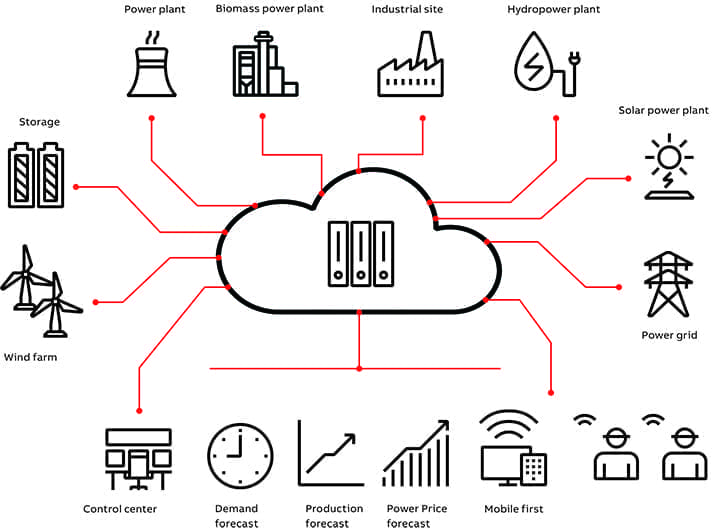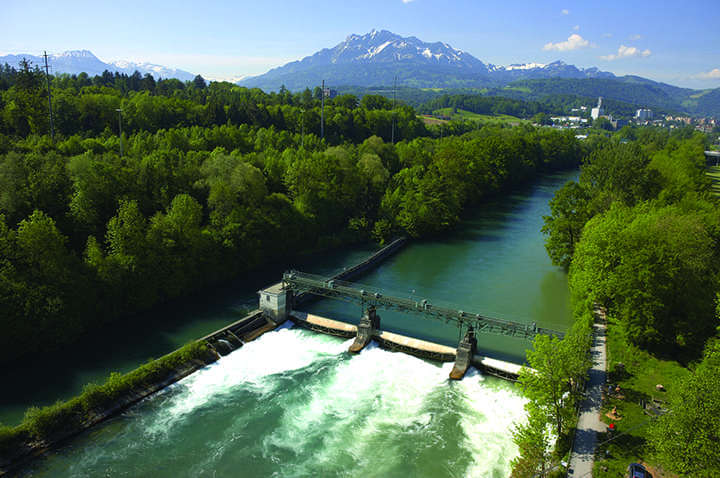Virtual power plants are becoming a driving force in the power sector. This article explains how they enable utilities and aggregators to pool production from multiple plants and distributed sources, achieving the flexibility and scale needed to take part and trade in the electricity market.
The energy landscape is changing. Megatrends are disrupting the energy and industrial situation worldwide. Greater urbanization, a drive for decarbonization, and the growing influence of digitalization are changing the way industrial goods are produced around the world, as well as how people are consuming and producing energy.
This, in turn, is driving a power grid transformation. It's changing how electricity is being generated, transported, and consumed. The move from a traditional grid to the new smart, decentralized grid with bi-directional energy and information flow has accelerated in the past couple of years due to technological innovations, cost reductions, new business models, and enabling policies.
However, one of the most significant factors driving change is the global move toward renewable and distributed power generation, which is severely disrupting the energy landscape. As the world moves further into the energy transition on the path to a low-carbon future, smaller and decentralized power generation units will dominate the market.
The result is a complex operational environment where generation is shifting from bulk, centrally controlled power plants to distributed and weather-dependent sources. The priority now for grid operators is to control and optimize those systems reliably and profitably. However, there is an advantage in looking beyond the basic requirements, as the changes in the energy landscape present a compelling opportunity to leverage the full benefits of digitalization.
Clean power generation like wind, solar, and hydro is cost-effective, and the penetration into the electricity generation landscape is growing. Building and connecting this renewable infrastructure is not on its own enough to replace fossil fuels while maintaining the current standard of on-demand and reliable power. Managing the grid has become such a complex operation that more and more digitalization is necessary, and finally, autonomous systems will take over. But the picture is much broader. The demand and consumption of energy has also changed remarkably.
Decarbonization has led to a change in the demand curve–with less power required during the day. At the same time, electrification has increased the demand for electricity, leading to an ever-steeper demand in the mornings and evenings, especially with the advent of e-mobility.
Renewable energy is increasing electrification and, therefore, electricity demand. The switch to renewable energy is encouraging a transition to electric vehicles (EVs). In fact, in some ways, the switch to EVs is going faster than the switch to renewables. But an EV charger draws a lot of power off the grid, and like behind-the-meter solar, grid operators do not know where EVs are in use or how many are on each distribution line.
The Rise of Virtual Power Plants
The electrification of heating and cooling is happening concurrently with more substantial variations in temperature. Electric heating and cooling can be more efficient than other options, depending on the geographic location and weather. That means a transition to electrification in temperature control as well as in transportation. But climate change is causing more extreme temperatures, which adds to the increase in electricity demand.
There is not one single solution for this challenge. The capacity of the ultra-high-voltage transmission grid needs to increase, but at the same time, local and regional network solutions need to strengthen. The local production and consumption of electricity should be encouraged. Here small-scale virtual power plants (VPPs) can balance renewable generation and consumption, and forecasting will help to steer consumers' behaviors with what is commonly referred to as demand response.
A VPP is a network of decentralized power generating units such as wind farms, solar parks, and combined heat and power (CHP) units, as well as flexible power consumers and storage systems. The interconnected units are dispatched through the central control room of the VPP but remain independent in their operation and ownership. The objective of a VPP is to relieve the load on the grid by smartly distributing the power generated by the individual units during periods of peak load. Additionally, the combined power generation and power consumption of the networked units in the VPP can trade on the energy exchange.
 |
|
1. A large variety of resources can be incorporated into a virtual power plant (VPP). The interconnected units can then be dispatched using special software and traded intelligently on the energy market. Courtesy: ABB |
One solution is ABB Ability Energy Management for sites–OPTIMAX for Virtual Power Plants aggregates and integrates decentralized energy generation, flexible loads, and storage systems to enable the cost-effective participation in energy markets. With a flexible and scalable system architecture, operators can customize and use it to implement innovative business models and trade intelligently on the energy market. They can also aggregate, control, monitor, and optimize the decentralized production of energy from distributed energy resources (DERs), such as wind, solar, CHP, biogas, hydropower, fossil steam, power-to-heat, diesel engines, and other types of power sources on and off the grid to meet local or regional needs. Energy storage facilities, such as batteries, thermal storage, compressed air, and pumped storage, can also be incorporated into a VPP (Figure 1).
This leads to entirely new and probably more lucrative business models for utilities and aggregators. The goal of a VPP operator is to run the pool of units optimally and generate maximum revenues for its participants by bidding smartly on the energy trading market.
Typically, there are three types of market participation for VPP operators. They can trade their power production on the energy market, using weather and load management forecasts, and real-time and historical data to adjust bidding and commitments. Secondly, as control unit production and to meet obligations during the day in response to price signals from the market, and thirdly, to provide balancing power to the transmission grid operators during periods of peak demand.
The design of the VPP is based on the type of market participation selected, the target customers (small-scale producers, businesses, or industrial sites), and the kinds of generation and storage that make up the VPP or pool. There are no off-the-shelf software solutions that can cover such a broad range of requirements. The control and optimization system must, therefore, be tailored to the needs of each VPP operator.
Adding Flexibility with a VPP
In Switzerland, Centralschweizerische Kraftwerke AG (CKW) wanted to create a large-scale VPP at Lucerne. It wanted to pool a diverse, decentralized network of 110 assets with a combined capacity of 1,400 MW. These assets included run-of-river plants (Figure 2), CHP plants, waste-to-power plants, industrial sites with controllable loads, conventional power plants, and wind and solar parks. The company also wanted the ability to scale up the VPP to include up to 1,000 assets.
 |
|
2. The Rathausen power plant is a run-of-river power station on the Reuss River in Switzerland. Centralschweizerische Kraftwerke AG (CKW) incorporated it into a VPP with a pool of other diverse resources, allowing the company to optimize operation of the network. Courtesy: CKW |
Using ABB OPTIMAX for Virtual Power Plants and ABB MicroSCADA, CKW was able to model the assets and their physical interdependencies. This allowed the company to optimize any given general schedule and dispatch power-efficient energy resources.
CKW was able to increase revenue by providing market access for small- and medium-sized assets as well as delivering significant time and cost savings when adding new assets. The ability to make fast decisions through accurate and easy-to-understand visualizations enabled new business models and revenue streams.
Increasing Renewable Penetration in Microgrids
The further the world moves in the direction of the sustainable energy landscape of the future, the more it will be able to use microgrids so that the central grid is more of a backup than a mainstay. Most importantly, this vision of the future is informed both by optimism about the power of technology to help utilities transition to renewable energy in a fast and stable way, and by a genuine awareness that such a grand transition will require coordination. Not just technical coordination, but policy and economic coordination at different levels in one geography and across borders. As has been seen in the pandemic, a crisis reveals the lack of a well-coordinated effort that involves policymakers, industry, and the public.
The use of VPPs can also help maximize the renewable content within microgrids while reducing operational costs and emissions, focusing on grid stability, as has been demonstrated on the Caribbean island of Aruba. The island has a population of 103,000 and a thriving tourism industry of 1.5 million visitors per year. WEB Aruba is the public utility responsible for supplying the island with reliable power and clean drinking water.
WEB Aruba has a generating capacity of 134 MW produced by thermal, wind, and solar photovoltaic plants. As part of its long-term ambition to become fuel-oil free, WEB Aruba intends to generate half its annual energy from renewables and the other half from alternative fuels by the end of this year. Given the volatility and intermittency of wind and solar power, it is vital for the island's grid stability and supply reliability that production and consumption are balanced.
ABB's extensive microgrid experience and a complete microgrid portfolio contribute to a control and optimization solution that allows the operator to meet its fuel-free target. The solution enables WEB Aruba to maximize renewable use and minimize dependence on fuel oil. Other features include day-ahead optimization based on weather and load forecasts, real-time optimization to balance fluctuations in supply and demand, and dynamic load-shedding to ensure grid stability.
Customers utilizing ABB's VPP solutions are able to have a high penetration of renewable generation. They can react faster and more accurately to changes in the network than conventional power plants, simply because of the higher granularity and smaller entities that are controlled.
For example, if 200 biomass plants each with a 20-MW capacity are spread over a country, the equivalent of a 4-GW power plant can be controlled in kW steps. That is something that could not be achieved with large coal or nuclear plants. The ability to control the grid at a local level and incorporate hundreds of disparate generation assets will open new opportunities and facilitate the move to a smart grid that can meet the needs of decarbonization and fluctuating demand while maintaining the reliability that is expected in the modern world. ■
–Sleman Saliba is global product manager for Energy Management with ABB Energy Industries.
